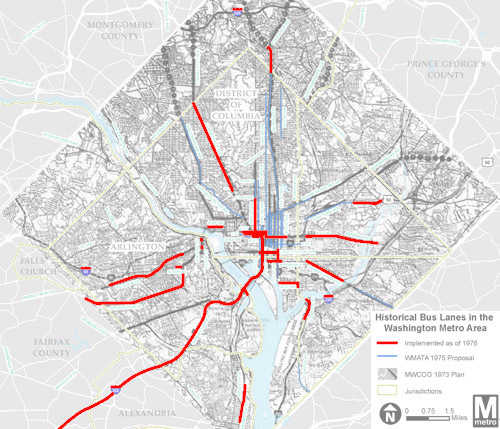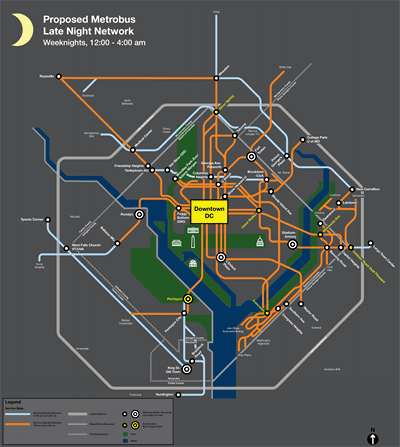How can we help people get around during SafeTrack?
Metro’s SafeTrack plan (plus any FTA-mandated changes) will mean weeks with no service, or month-long single-tracking, on big sections of the rail system. Our region will need to help people get around in other ways that avoid crippling traffic. How do we do that?
Most of our major roads are already full during peak periods. Some Metro “surges” will disrupt travel for tens of thousands of people. If even a small proportion of these Metro riders drive alone, we could see major regional gridlock.
While the “surges” won’t close the whole system at once, their effects will reverberate throughout the region. Lines with single tracking will see fewer trains overall, and the closures and decreased service will likely push people who connect from other lines to commute some other way. All of this means significant traffic impacts far from any given work zone.
What should the region do?
We talked with a number of transportation professionals for their thoughts. But we’d also like to hear yours. We’ll compile a list of promising measures, and we’re working with the Coalition for Smarter Growth on a tool for you to reach out to your local DOT and elected leaders to ask them to make it happen. Sign up here and you’ll be the first to know when it’s ready to go.
Get SafeTrack updates!
Here are the ideas we heard:
Teleworking is the biggest no-brainer. Many people can telework. But many more cannot. If people who can, do, that would alleviate some of the crunch. But not all.
Bus lanes. A lot of people will switch to the bus. But if they are stuck in traffic, they’re not able to get to the ends of their routes and start the next run, effectively cutting down on bus capacity. The bus would also then be an unpleasant way to travel, pushing more people into cars instead, making driving and riding the bus worse, and so on.
The Washington region actually had a network of bus lanes before Metrorail opened. Without the trains, those lanes helped get people in and out of job centers. We need them again.
Walking and bicycling are an appealing alternative people who live close to work. Capital Bikeshare capacity and bike parking are likely to be some of the biggest crunches for bicycling. In Metro-accessible job centers like downtown DC, Silver Spring, Rosslyn, and others, bike corrals could help keep Capital Bikeshare balanced, and help people riding their own bikes find a place to park.
Carpooling can fit more people into fewer vehicles, making more efficient use of the road space we have. Some people may carpool without any prodding. But even more people will carpool if there are incentives to do it, like:
- HOV lanes. On key arterials, one lane could be made HOV for a year. Both buses and carpoolers could use these to get a faster ride, making it more worthwhile to carpool or ride the bus.
- Slugging. About 10,000 Virginians ride with strangers every day. Drivers pick up these strangers to get to use the I-395 carpool lanes, a practice called slugging. There are designated areas for people to park and then find rides. If DC added HOV lanes on key arterials from Maryland to downtown, Maryland counties could help find places, like shopping center parking lots that go mostly empty on weekdays, to serve as slug pickup areas. The same goes for Virginia routes into DC besides 395.
- Employer incentives. Employers could help people carpool, such as by offering reserved parking, running programs to match people up, or simply trying to structure the work day to make carpooling more feasible. Carpooling has declined as people’s work schedules became more irregular; employers can reverse that trend, at least for the year.
- Business incentives. Retail businesses can play a role, too. Restaurants and shops could find ways to offer discounts or specials to people who biked or carpooled.
- Ride-matching services. Existing programs like Commuter Connections run bulletin boards and employer programs to match people to potential carpool or vanpool buddies.
- Apps like Split, UberPool, and Lyft Line already try to match up people to share rides. Carpool lanes would create an even stronger incentive to use them. Or, governments could work with these companies to find other ways to increase the incentive to try them.
Special parking lots and shuttles. When a Metro line section shuts down, there could be a temporary park-and-ride with shuttle buses. For example, RFK’s parking lots are huge and almost always empty. They could serve as a commuter parking lot and special buses could zip people (ideally, on a temporary HOV lane on I-695 and I-395) to the Capitol and downtown job centers. Where else could this work?
Optimize bus routes. Besides (or ideally in addition to) adding bus lanes, there are ways to boost capacity on major bus lines, especially the ones paralleling Metro lines (like the S and 70s buses from Silver Spring to downtown DC, when the eastern Red Line shuts down). Some approaches:
- Add express buses. Metro has a dedicated fleet of 42 buses to add to areas with shutdowns. Local transportation officials are already thinking about how to best deploy these. Other than a direct “bus bridge” between closed stations, some could be new express service on likes like the S9 and 79. A few local buses could switch to express during the shutdown as well.
- Restrict on-street parking. Many DC arterial roads have parking on the non-peak side during rush hour, and on both sides at other times. The road could carry more vehicles without that. But it’s best to make the new lane a bus or HOV lane, so that people have an incentive to carpool or take the bus instead of consuming all that capacity with new single-passenger trips.
- Fix chokepoints. Likewise, Metro already knows where the major bus routes waste the most time. Retiming a signal, temporarily removing some parking, or adding an interim turn lane could clear out those spots. Where do you think are the most important places for this?
- Reroute buses that end at a Metro station. For example, the 80s buses on Rhode Island Avenue almost all end at Rhode Island Avenue Metro. But when the eastern Red Line shuts down, then what? Those buses could go downtown — but will need places to drop off, and bus or HOV lanes (sense a theme?) could ensure they don’t spend more time doing so than necessary.
Drop-off zones. If more people carpool and take buses, more curbside space may need to be devoted to letting people load and unload, either from commuter buses that already come in from farther out areas, for carpoolers, and for riders of app services who share rides instead of riding alone.
Improve late night bus service. Metro plans to shut down at midnight instead of 3 am. While the number of people who ride Metro at night has dropped as many people switch to ride-hailing services, it’s still important to offer an affordable way for people to get home.
- Make a late night map. Metro could publish a special map showing late night bus service, especially the routes that take people between Metro stations. Most people don’t even know if there’s a bus that can take them from nightlife to their neighborhoods.
- Add late-night service. If some stations get decent late-night traffic but don’t have late-night bus service (like more outlying park-and-ride stations), add buses to those spots until 3 am or later.
These general ideas cover a lot of ground, but it’s a daunting task for our local transportation departments to identify all the spots which need attention. Many of these ideas will require local DOTs and WMATA to work together, or inter-jurisdictional cooperation between DOTs. But that doesn’t meant they can’t happen.
Where would you implement these strategies? What other ideas do you have? Give your thoughts in the comments.





